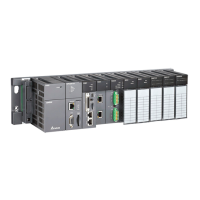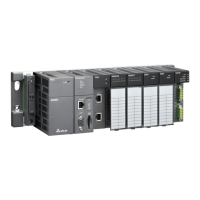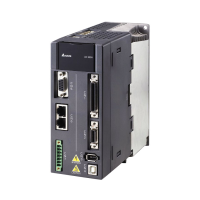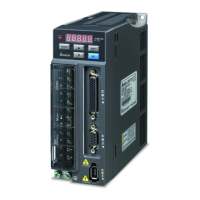AH500 Hardware and Operation Manual
5-8
5.2.6 Auxiliary Relays
The auxiliary relay has contact A and contact B. It can be used several times in the program. Users can
combine the control loops by means of the auxiliary relay, but can not drive the external load by means of the
auxiliary relay. The auxiliary relays can be divided into two types according to their attributes.
If an electric power cut occurs when the PLC is running, the auxiliary relay for
general use will be reset to OFF. When the power supply is restored, the auxiliary
relay for general use is still OFF.
If an electric power cut occurs when the PLC is running, the state of the auxiliary
relay for latched use will be retained. When the power supply is restored, the state
remains the same as that before the power electric cut.
5.2.7 Special Auxiliary Relays
Every special auxiliary relay has its specific function. Please refer to section 2.2.7 in AH500 Programming
Manual for more information.
5.2.8 Stepping Relays
Function of the stepping relay:
The stepping relay can be easily used in the industrial automation to set the procedure. It is the most basic
device in the sequential function chart (SFC). Please refer to ISPSoft User Manual for more information
related to sequential function charts.
There are 2048 stepping relays, i.e. S0~S2047. Every stepping relay is like an output relay in that it has an
output coil, contact A, and contact B. It can be used several times in the program, but it can not directly drive
the external load. Besides, the stepping relay can be used as a general auxiliary relay when it is not used in
the sequential function chart.
5.2.9 Timers
1. 100 millisecond timer: The timer specified by the instruction TMR takes 100 milliseconds as the timing
unit.
2. 1 millisecond timer: The timer specified by the instruction TMRH takes 1 millisecond as the timing unit.
3. The timers for the subroutine’s exclusive use are T1920~T2047.
4. The accumulative timers are ST0~ST2047. If users want to use the device-monitoring function, they can
monitor T0~T2047.
5. If the same timer is used repeatedly in the program, including in different instructions TMR and TMRH, the
setting value is the one that the value of the timer matches first.
6. If the same timer is used repeatedly in the program, it is OFF when one of the conditional contacts is OFF.
7. If the same timer is used repeatedly in the program as the timer for the subroutine’s exclusive use and the
accumulative timer in the program, it is OFF when one of the conditional contacts is OFF.
8. When the timer is switched from ON to OFF and the conditional contact is ON, the timer is reset and
counts again.
9. When the instruction TMR is executed, the specified timer coil is ON and the timer begins to count. As the
value of the timer matches the setting value, the state of the contact is as follows.
Normally open (NO) contact
Normally closed (NC) contact
General-purpose timer
When the instruction TMR is executed, the general-purpose timer begins to count. As the value of the
timer matches the setting value, the output coil is ON.
Accumulative timer
When the instruction TMR is executed, the accumulative timer begins to count. As the value of the timer
matches the setting value, the output coil is ON. As long as users add the letter S in front of the letter T,

